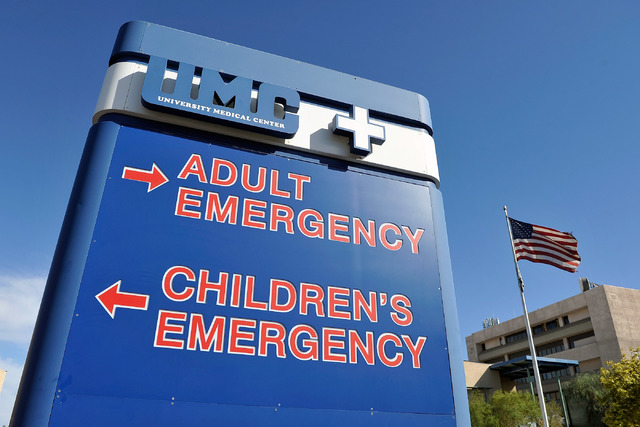Local emergency rooms face patient crush
A spike in the number of patients seeking emergency room care for flu-like symptoms is forcing valley hospitals to close to ambulances, according to the Southern Nevada Health District.
The health district issued a statement Tuesday evening that advised the ailing to think twice before going to emergency rooms. They also asked hospitals to closely monitor staff and equipment supplies to accurately assess whether closing to new patients is necessary, Chief Health Officer Dr. Joseph Iser said Tuesday night.
Several hospitals declared states of “internal disaster” in their emergency departments Monday and Tuesday, prompting a Tuesday evening conference call with Iser and officials with Clark County hospitals.
Iser said such declarations result from at least one of two conditions. The hospital either has so many patients that crowding poses a threat to the health of other patients; or the hospital is running out of personnel or equipment and can’t take on new patients.
In this case, Iser said, it’s a combination of both. This is the first time since March 2014 that such an event has impacted the entire hospital system in Southern Nevada.
When a hospital declares a state of internal disaster, it creates a cascade effect as ambulances are forced to go to the next closest hospital with vacant beds, Iser said.
Seven hospitals temporarily closed to ambulances for several hours at a time after declaring internal disaster conditions as of 7 p.m. Monday. Four hospitals had done so by 5 p.m. on Tuesday. Iser said hospital administrators and emergency response managers were concerned that Tuesday’s numbers might increase through the night.
Isera declined to name the hospitals that had temporarily closed ERs because he wasn’t sure of their current statuses. He didn’t know the wait times for patients in ER waiting rooms, but said that ambulances were seeing lengthy delays.
Ambulances were forced to wait outside of hospitals for 45 to 48 minutes Monday night before patients were off-loaded. Though he couldn’t give the average wait time ambulances face at hospitals, Iser said Monday’s figures were well above normal.
The last time the health district had a conference call with officials from the county’s 16 to 18 hospitals — including those in Boulder City and Mesquite — was in March, Iser said. The 2014 conference call addressed the high number of mentally ill patients contributing to crowding in emergency department waiting rooms, Iser said.
Though one hospital on Tuesday evening reported having 29 mentally ill patients in its emergency department waiting room, the hospitals were in consensus that the flu and influenza-like illnesses were the biggest culprits in the “heavier than normal patient volumes.”
“As the flu and other respiratory illnesses continue to circulate in the community, it is sometimes difficult for the public to determine whether it is appropriate to go to an emergency department, an urgent care center or a primary care physician,” health district spokeswoman Jennifer Sizemore wrote in the release.
Sizemore said symptoms that generally indicate an emergency include: uncontrollable bleeding, head injury or broken bones, poisoning or suspected overdose, inability to breathe or shortness of breath, seizure or loss of consciousness, persistent chest or abdominal pain or pressure, numbness or paralysis of an arm or leg, sudden slurred speech, visual changes or weakness, major burns, intense pain or severe reaction to an insect bite, medication or food.
Symptoms that warrant a visit to an urgent care center include: moderate fever, colds, cough or flu, bruises, abrasions and minor cuts, minor burns, eye, ear or skin infections, sprains or strains, urinary tract infections or respiratory infections.
The district noted that the elderly, or anyone with a chronic medical condition could be more at risk for complications from the flu and should speak with their primary doctor before going to an emergency room.
Iser urged anyone with mild symptoms to wait until the morning to visit the emergency room.
Contact Kimber Laux at klaux@reviewjournal.com or 702-383-0381. Find her on Twitter: @lauxkimber.

















